
Marine angelfish are perciform fish of the family Pomacanthidae. They are found on shallow reefs in the tropical Atlantic, Indian, and mostly western Pacific Oceans. The family contains seven genera and about 86 species. They should not be confused with the freshwater angelfish, tropical cichlids of the Amazon Basin.

The black neon tetra is a freshwater fish of the characin family of order Characiformes. It is native to the Paraguay basin of southern Brazil. They are often found in the aquarium trade.

Sterba's corydoras is a member of the South American Corydoras genus of freshwater aquarium catfish and one of the most popular species of Corydoras due to its attractive markings. The fish is native to the Guaporé River region between Bolivia and Brazil.

Maylandia estherae is a haplochromine cichlid. It is a rock dwelling fish or mbuna from Lake Malawi. This fish, like most cichlids from Lake Malawi, is a mouthbrooder - females hold their fertilized eggs then fry in their mouths until they are released after about 21 days.

The Japanese angelfish or Japanese pygmy angelfish, is a species of marine ray-finned fish, a marine angelfish belonging to the family Pomacanthidae. It is found in the western Pacific Ocean.
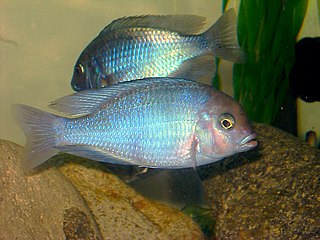
Cyrtocara moorii, commonly known as the hump-head, is a species of haplochromine cichlid endemic to Lake Malawi in east Africa where they prefer areas with sandy substrates. It can grow to a length of 20 centimetres (7.9 in) TL. The species is popular among aquarium keepers where it is known as the hump-head cichlid, blue dolphin cichlid, Malawi dolphin or simply as moorii. It is currently the only known member of its genus. The specific name honours the English cytologist and biologist John Edmund Sharrock Moore (1870-1947).

Pseudochromis aldabraensis, the orange dottyback, neon dottyback or Arabian dottyback, is a species of ray-finned fish from the family Pseudochromidae, the dottybacks. It is commonly kept in marine aquariums.

The electric blue hap is a species of cichlid fish endemic to Lake Malawi. It prefers to live in caves and crevices in rocky substrates. This species can reach a length of 20 centimetres (7.9 in) TL. It can also be found in the aquarium trade.

The royal dottyback, also called the bicolor dottyback or false gramma is a fish commonly kept in marine aquariums. The front of the fish is bright purple and the posterior is yellow. In an aquarium, it will grow up to three inches long. The dottyback will defend its territory against fish several times its size, but gets along with many other common aquarium fish. This is sometimes mistaken for a royal gramma.

Pseudochromis fridmani is a species of fish in the family Pseudochromidae, the dottybacks. Its common name is orchid dottyback. It is endemic to the Red Sea.

Pseudochromis steenei, also known as lyretail dottyback, is a saltwater fish from Indonesia that is occasionally kept in aquariums. The specific name honours the Australian naturalist and underwater photographer Roger C. Steene who assisted in the collection of the type specimen.
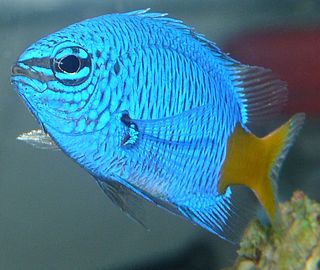
Chrysiptera parasema, also known as yellowtail damselfish, yellowtail blue damsel, goldtail demoiselle, and other variations, is a popular saltwater aquarium fish from the Indo-Pacific. It was described by Fowler in 1918.

Dascyllus reticulatus, known commonly as the reticulate dascyllus or two-stripe damselfish among other vernacular names, is a species of marine fish in the family Pomacentridae.

Chrysiptera hemicyanea, known commonly as the azure damselfish, azure demoiselle, half-blue demoiselle, and yellow-dipped damsel, is a species of damselfish.
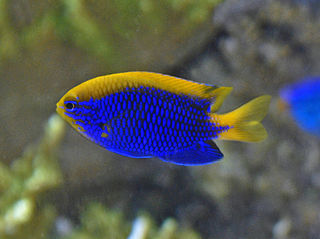
Chrysiptera starcki is a species of damselfish known by the common name Starck's demoiselle. It is native to the western Pacific Ocean, where it has been reported from the Ryukyu Islands and Taiwan to Australia, New Caledonia, and Tonga. It was originally described in 1973 as Abudefduf starcki.
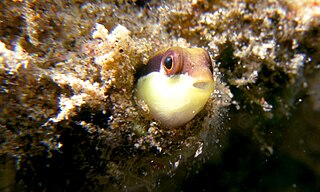
Pseudochromis sankeyi, the striped dottyback, is a species of ray-finned fish from the Western Indian Ocean which is a member of the family Pseudochromidae. It occasionally makes its way into the aquarium trade. It grows to a size of 7 cm in length. The specific name honours the British collector and wholesaler of marine fish Richard D. Sankey, who gave Roger Lubbock study specimens.
Manonichthys alleni, the Sabah dottyback is a species of ray-finned fish from the family Pseudochromidae, the dottybacks. It occasionally makes its way into the aquarium trade. It grows to a size of 12 centimetres (4.7 in) in length. This dottyback has only been known from Indonesia and Malaysia, but was recently recorded in the Davao Gulf in the southern Philippines. The specific name honours the ichthyologist Gerald R. Allen of the Western Australian Museum in Perth who collected the type specimen and provided photographs of this species which Gill used in his description, as well as being in recognition of Allen's contribution to the knowledge of Indo-Pacific fish and of the support Allen gave Gill in is work on the Pseudochromidae.

Apistogramma agassizii is the scientific name for the Agassiz's dwarf cichlid, a fish that occurs in many Southern tributaries of the Amazon river. Its specific name honours the Swiss-American zoologist and geologist Louis Agassiz (1807-1873).
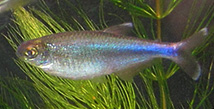
Boehlkea fredcochui, also known as the Cochu's blue tetra is a species of characin. Its natural range is in the Amazon Basin. It is commonly kept as an aquarium fish.

The gold tetra is a species of small freshwater fish in the family Characidae native to lowland South America, where they are abundant in coastal floodplains. Their name comes from a powdery golden tint on their body that is thought to be caused by internal parasites. Gold tetras are peaceful, hardy, schooling community fish. Gold tetras have been successfully bred in captivity.


















